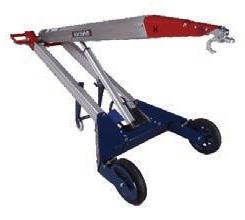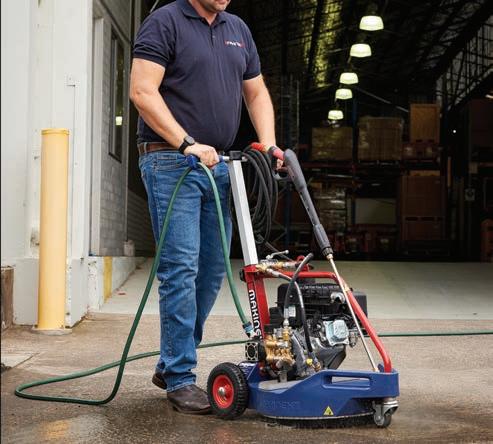
5 minute read
Prioritising safe work
Drawing on the experience and expertise of the members of the Access Industry, EWPA have developed the Mobile Elevating Work Platforms (MEWP) Safe Working Condition Guide, which was launched in July to raise awareness of the risk associated when MEWPs are damaged or contaminated.
When used correctly, they’re an effective way to safely work at height, and have a proven record in reducing accidents when operated and maintained in a proper working order. Their versatility and adaptability mean that these machines are used in a wide range of applications and many various industries. However, people have been seriously injured and killed in accidents involving MEWPs. While the complete and comprehensive guide is available online, HRIA is pleased to provide an overview of the advice covered.
The basics
MEWPs require maintenance to keep them in a safe working condition. And while they can be used in harsh environments including construction sites, tunnels, mining, demolition, ground engineering and other industrial settings, when used in severe conditions additional measures must be taken for safe operation. The work environment, plus the frequency and severity of use can significantly impact the working condition of the MEWP. It can be exposed to a variety of occupational and environmental hazards that could affect the safe working condition of the machine.
If its shotcreting, demolition, painting, or other severe applications, it is common for a MEWP to be covered in overspray, paint, concrete, slag, excessive dust and other substances or damaged from collision. This can reduce the function and effectiveness of components critical to the occupants’ safety such as operating controls, safety devices, emergency lowering devices, moving parts, instructions and warning decals. It can also conceal areas of damage and
ELEVATING WORK PLATFORM ASSOCIATION OF AUSTRALIA
Information Sheet
MEWP Safe Working Condition
Keeping the machine in a safe and satisfactory condition when operating in harsh environments
Mobile Elevating Work Platforms (MEWPs) can be used in harsh environments such as – construction sites, tunnels, mining, demolition, ground engineering and other industrial settings. When used in these severe conditions then additional measures must be taken for safe operation.
What work environments
The work environment, plus the frequency and severity of use can significantly impact the working condition of the MEWP. It can be exposed to a variety of occupational and environmental hazards that could affect the safe working condition of the machine.
If its shotcreting, demolition, painting, or other severe applications, it is common for a MEWP to be covered in overspray, paint, concrete, slag, excessive dust and other substances or damaged from collision. This can reduce the function and effectiveness of components critical to the occupants’ safety such as operating controls, safety devices, emergency lowering devices, moving parts, instructions and warning decals. It can also conceal areas of damage and inhibit proper visual inspection during operational and maintenance checks.
Without implementing adequate measures, the MEWP can place the occupants and other people at risk of serious injury or death.
MEWP Condition Version 1 www.ewpa.com.au
Page 1 | 4
inhibit proper visual inspection during operational and maintenance checks. Without implementing adequate measures, the MEWP can place the occupants and other people at risk of serious injury or death.
When is it unsafe?
The MEWP manufacturer’s manuals outline the key operating and maintenance requirements needed to keep MEWPs in a safe and satisfactory condition. A MEWP that is damaged, covered in debris or exposed to contamination may not function correctly. The consequences range from operating and emergency controls becoming faulty or failing to return to neutral to overturning or structural failure.
To mitigate these risks, you can select and use a MEWP that is suitable for the task and environment and discuss accessories or options that are designed for working in harsh environments with the manufacturer. It’s also recommended an appropriate risk assessment focusing on what to check for in harsh conditions is conducted and areas that need additional protection are identified. Longer term, using protective coverage on control boxes and other key elements where required is recommended, as is conducting daily and pre-operation inspections – including checking that the
interior of booms, chassis and wheels/ tracks are clean and clear and overspray and debris is regularly cleaned off. MEWPs that are deemed to be in an unsafe condition need to be immediately removed from service and tagged with the information recorded in the logbook. You should refer to the EWPA Good Practice Guide for pre-operation checks and routine inspections – and if you can’t keep it clean and maintain it, don’t use it.
The EWPA provides safety and technical resources plus training programs, including the EWPA Yellow Card. To find out more about the EWPA or to download the MEWP Safe Working Condition Guide, please visit www.ewpa.com.au or call 02 9998 2222.

Makinex Materials Handling & Cleaning


Solutions 1300 795 953 | makinex.com.au
Dual Pressure Cleaner 2200
The Dual Pressure Cleaner 2200 combines a pressure wand and rotary surface cleaner with 2200 psi pressure control in one
Benefits –
Spray gun wand and rotary cleaner in one 18” wide precision-made surface cleaner Front swivel wheel with brake stops it rolling away Telescopic handle for more compact storage Lightweight at 33 kgs

Powered Hand Truck

The Makinex Powered Hand Truck is a universal materials handling solution that enables one person to safely li and load equipment or bulky objects weighing up to 140kg on and o trucks and trailers.
Benefits –
Avoid back injury li ing heavy objects Easy to use and requires no licenses to operate A achments to handle di erent pe of objects Folds flat for easy storage and transportation Auto cut o to prevent accidental ba ery drain










